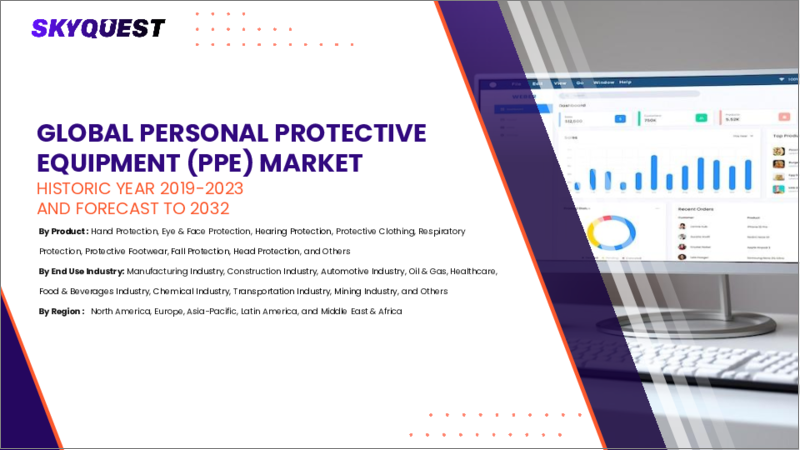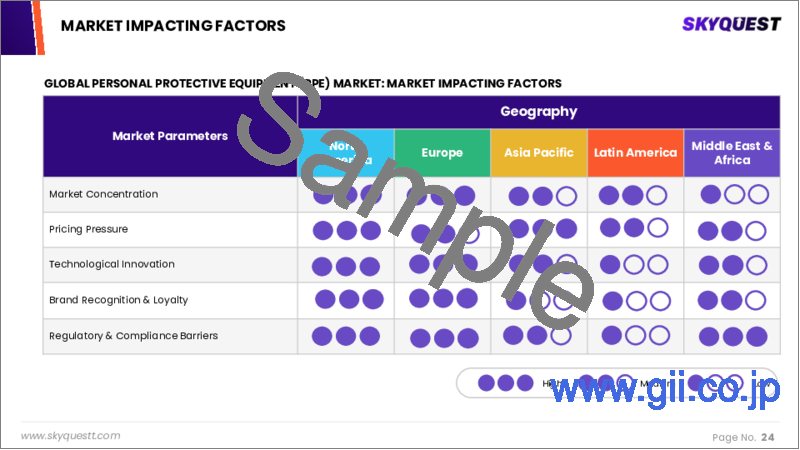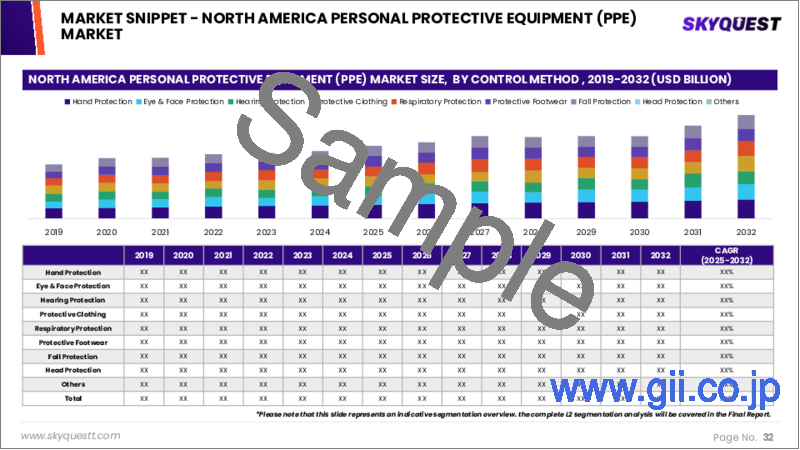|
|
市場調査レポート
商品コード
1623833
個人用保護具(PPE)の市場規模、シェア、成長分析、製品別、最終用途別、地域別 - 産業予測、2025~2032年Personal Protective Equipment (PPE) Market Size, Share, Growth Analysis, By Product (Head Protection, Eye Protection), By End Use (Construction, Manufacturing), By Region - Industry Forecast 2025-2032 |
||||||
|
|||||||
| 個人用保護具(PPE)の市場規模、シェア、成長分析、製品別、最終用途別、地域別 - 産業予測、2025~2032年 |
|
出版日: 2024年12月25日
発行: SkyQuest
ページ情報: 英文 157 Pages
納期: 3~5営業日
|
全表示
- 概要
- 目次
個人用保護具(PPE)の世界市場規模は、2023年に801億米ドルと評価され、2024年の899億米ドルから2032年には1,285億9,000万米ドルに成長し、予測期間(2025-2032年)のCAGRは5.4%で成長する見通しです。
個人用保護具(PPE)の需要は引き続き堅調で、職場の危険性を軽減し、感染症を含む様々な健康リスクから個人を保護するという重要な役割を担っています。手袋、ゴーグル、人工呼吸器、防護服などのPPEは、特に外科手術の際に感染性物質への曝露を防ぐヘルスケアなど、さまざまな産業で不可欠です。PPEの効果的な使用と適切な廃棄は、感染症のトランスミッションを防ぐ上で極めて重要です。ユニセフは、特にCOVID-19への対応において、PPEの世界の配布と調達において極めて重要な役割を果たしており、パンデミックが始まって以来、140カ国に6億5,340万個以上を届けています。これは、Humanitarian Action for Children Appeal(子どものための人道的行動アピール)のようなイニシアチブからの資金や、政府機関からの拠出金によって支えられています。
目次
イントロダクション
- 調査の目的
- 調査範囲
- 定義
調査手法
- 情報調達
- 二次データと一次データの方法
- 市場規模予測
- 市場の前提条件と制限
エグゼクティブサマリー
- 世界市場の見通し
- 供給と需要の動向分析
- セグメント別機会分析
市場力学と見通し
- 市場概要
- 市場規模
- 市場力学
- 促進要因と機会
- 抑制要因と課題
- ポーターの分析
主な市場の考察
- 重要成功要因
- 競合の程度
- 主な投資機会
- 市場エコシステム
- 市場の魅力指数(2024年)
- PESTEL分析
- マクロ経済指標
- バリューチェーン分析
- 価格分析
個人用保護具(PPE)市場規模:製品別
- 市場概要
- 頭部保護
- ヘルメット
- バンプキャップ
- 目の保護
- 安全メガネ
- ゴーグル
- 顔の保護
- フルフェイスシールド
- ハーフフェイスシールド
- 聴覚保護
- イヤーマフ
- 耳栓
- 防護服
- 熱と炎からの保護
- 化学防御
- クリーンルーム用衣類
- 機械防護服
- 限定的な一般使用
- その他
- 呼吸器の保護
- 空気清浄呼吸器
- 給気呼吸器
- 保護靴
- レザー
- ゴム
- PVC
- ポリウレタン
- その他
- 落下防止
- ソフトグッズ
- ハードグッズ
- その他
- 手の保護
- 使い捨てタイプ
- 汎用
- 化学物質の取り扱い
- 滅菌手袋
- 外科手術
- その他
- 材質別使い捨て
- 天然ゴム
- ニトリル
- ビニール
- ネオプレン
- ポリエチレン
- その他
- 耐久性
- 機械用手袋
- 化学物質の取り扱い
- 耐熱性/難燃性
- その他
- その他
個人用保護具(PPE)市場規模:最終用途別
- 市場概要
- 工事
- 製造業
- 石油・ガス
- 化学薬品
- 食べ物
- 医薬品
- ヘルスケア
- 交通機関
- 鉱業
- その他
個人用保護具(PPE)市場規模
- 北米
- 米国
- カナダ
- 欧州
- ドイツ
- スペイン
- フランス
- 英国
- イタリア
- その他欧州地域
- アジア太平洋地域
- 中国
- インド
- 日本
- 韓国
- その他アジア太平洋地域
- ラテンアメリカ
- ブラジル
- その他ラテンアメリカ地域
- 中東・アフリカ
- GCC諸国
- 南アフリカ
- その他中東・アフリカ
競合情報
- 上位5社の比較
- 主要企業の市場ポジショニング(2024年)
- 主な市場企業が採用した戦略
- 市場の最近の動向
- 企業の市場シェア分析(2024年)
- 主要企業の企業プロファイル
- 会社概要
- 製品ポートフォリオ分析
- セグメント別シェア分析
- 収益の前年比比較(2022-2024)
主要企業プロファイル
- 3M(USA)
- Honeywell International Inc.(USA)
- DuPont de Nemours, Inc.(USA)
- MSA Safety Incorporated(USA)
- Ansell Limited(Australia)
- Kimberly-Clark Corporation(USA)
- Lakeland Industries, Inc.(USA)
- Moldex-Metric, Inc.(USA)
- Uvex Winter Holding GmbH & Co. KG(Germany)
- Dragerwerk AG & Co. KGaA(Germany)
- Bullard(USA)
- Radians, Inc.(USA)
- Delta Plus Group(France)
- JSP Ltd(UK)
- Protective Industrial Products, Inc.(PIP)(USA)
- Superior Glove Works Ltd.(Canada)
- Showa Glove Co.(Japan)
- Towa Corporation(Japan)
- ARISTA Industries, Inc.(USA)
- MCR Safety(USA)
結論と推奨事項
Global Personal Protective Equipment (PPE) Market size was valued at USD 80.1 billion in 2023 and is poised to grow from USD 89.9 billion in 2024 to USD 128.59 billion by 2032, growing at a CAGR of 5.4% during the forecast period (2025-2032).
The demand for personal protective equipment (PPE) remains strong, driven by its crucial role in mitigating workplace hazards and protecting individuals from various health risks, including infections. PPE such as gloves, goggles, respirators, and protective clothing is essential across several industries, notably healthcare, where it safeguards against exposure to infectious materials, particularly during surgical procedures. Effective use and proper disposal of PPE are critical to preventing infection transmission. UNICEF plays a pivotal role in the global distribution and procurement of PPE, particularly in response to COVID-19, having delivered over 653.4 million units to 140 countries since the pandemic began, supported by funding from initiatives like the Humanitarian Action for Children Appeal and contributions from government entities.
Top-down and bottom-up approaches were used to estimate and validate the size of the Global Personal Protective Equipment (Ppe) market and to estimate the size of various other dependent submarkets. The research methodology used to estimate the market size includes the following details: The key players in the market were identified through secondary research, and their market shares in the respective regions were determined through primary and secondary research. This entire procedure includes the study of the annual and financial reports of the top market players and extensive interviews for key insights from industry leaders such as CEOs, VPs, directors, and marketing executives. All percentage shares split, and breakdowns were determined using secondary sources and verified through Primary sources. All possible parameters that affect the markets covered in this research study have been accounted for, viewed in extensive detail, verified through primary research, and analyzed to get the final quantitative and qualitative data.
Global Personal Protective Equipment (Ppe) Market Segmental Analysis
Global Personal Protective Equipment (PPE) Market is segmented by product, end use and region. Based on product, the market is segmented into head protection, eye protection, face protection, hearing protection, protective clothing, respiratory protection, protective footwear, fall protection, hand protection and others. Based on end use, the market is segmented into construction, manufacturing, oil & gas, chemicals, food, pharmaceuticals, healthcare, transportation, mining and others. Based on region, the market is segmented into North America, Europe, Asia Pacific, Latin America and Middle East & Africa.
Driver of the Global Personal Protective Equipment (Ppe) Market
The global market for Personal Protective Equipment (PPE) is being significantly driven by several key factors, including a rise in workplace fatalities, stricter government regulations, growing public consciousness regarding personal safety, and advancements in PPE technology. Organizations such as the International Labour Organization (ILO) and the Occupational Safety and Health Administration (OSHA) are emphasizing stringent regulations for PPE usage as incident rates in workplaces increase. This regulatory focus has significantly spurred market growth, which is expected to persist. Moreover, the ongoing rise in workplace injuries-often resulting from electrocutions, falls, and being caught in machinery-further highlights the critical need for effective PPE to protect workers from various hazards, including physical, chemical, biological, electrical, and mechanical risks.
Restraints in the Global Personal Protective Equipment (Ppe) Market
The Global Personal Protective Equipment (PPE) market is facing notable constraints due to the increasing incorporation of automation and the Internet of Things (IoT) across various manufacturing sectors in both developed and developing countries. While these advancements aim to enhance productivity and minimize costs, they pose significant challenges for the PPE industry. One critical issue is the degradation of materials used in PPE, which can lead to potential electric shock hazards over time. As more businesses turn to automated solutions, ensuring the reliability and safety of protective equipment becomes increasingly complex, ultimately hindering market growth.
Market Trends of the Global Personal Protective Equipment (Ppe) Market
The Global Personal Protective Equipment (PPE) market is currently witnessing three significant trends that are reshaping its landscape across all regions and product categories. Firstly, the heightened focus on worker safety in response to the COVID-19 pandemic has led to an increased demand for advanced PPE solutions, including smart and connected devices that enhance protection. Secondly, sustainability is becoming a central theme as manufacturers pivot towards eco-friendly materials and production processes, responding to both regulatory pressures and consumer preferences. Lastly, the integration of technology, such as IoT and AI, is transforming PPE into more efficient and data-driven solutions, driving innovation and increasing market competitiveness.
Table of Contents
Introduction
- Objectives of the Study
- Scope of the Report
- Definitions
Research Methodology
- Information Procurement
- Secondary & Primary Data Methods
- Market Size Estimation
- Market Assumptions & Limitations
Executive Summary
- Global Market Outlook
- Supply & Demand Trend Analysis
- Segmental Opportunity Analysis
Market Dynamics & Outlook
- Market Overview
- Market Size
- Market Dynamics
- Drivers & Opportunities
- Restraints & Challenges
- Porters Analysis
- Competitive rivalry
- Threat of substitute
- Bargaining power of buyers
- Threat of new entrants
- Bargaining power of suppliers
Key Market Insights
- Key Success Factors
- Degree of Competition
- Top Investment Pockets
- Market Ecosystem
- Market Attractiveness Index, 2024
- PESTEL Analysis
- Macro-Economic Indicators
- Value Chain Analysis
- Pricing Analysis
Global Personal Protective Equipment (PPE) Market Size by Product & CAGR (2025-2032)
- Market Overview
- Head Protection
- Hard Hats
- Bump Caps
- Eye Protection
- Safety Glasses
- Goggles
- Face Protection
- Full Face Shields
- Half Face Shields
- Hearing Protection
- Earmuffs
- Earplugs
- Protective Clothing
- Heat & Flame Protection
- Chemical Defending
- Clean Room Clothing
- Mechanical Protective Clothing
- Limited General Use
- Others
- Respiratory Protection
- Air-Purifying Respirator
- Supplied Air Respirators
- Protective Footwear
- Leather
- Rubber
- PVC
- Polyurethane
- Others
- Fall Protection
- Soft Goods
- Hard Goods
- Others
- Hand Protection
- Disposable By Type
- General Purpose
- Chemical Handling
- Sterile Gloves
- Surgical
- Others
- Disposable By Material
- Natural Rubber
- Nitrile
- Vinyl
- Neoprene
- Polyethylene
- Others
- Durable
- Mechanical Gloves
- Chemical Handling
- Thermal/Flame Retardant
- Others
- Others
Global Personal Protective Equipment (PPE) Market Size by End Use & CAGR (2025-2032)
- Market Overview
- Construction
- Manufacturing
- Oil & Gas
- Chemicals
- Food
- Pharmaceuticals
- Healthcare
- Transportation
- Mining
- Others
Global Personal Protective Equipment (PPE) Market Size & CAGR (2025-2032)
- North America (Product, End Use)
- US
- Canada
- Europe (Product, End Use)
- Germany
- Spain
- France
- UK
- Italy
- Rest of Europe
- Asia Pacific (Product, End Use)
- China
- India
- Japan
- South Korea
- Rest of Asia-Pacific
- Latin America (Product, End Use)
- Brazil
- Rest of Latin America
- Middle East & Africa (Product, End Use)
- GCC Countries
- South Africa
- Rest of Middle East & Africa
Competitive Intelligence
- Top 5 Player Comparison
- Market Positioning of Key Players, 2024
- Strategies Adopted by Key Market Players
- Recent Developments in the Market
- Company Market Share Analysis, 2024
- Company Profiles of All Key Players
- Company Details
- Product Portfolio Analysis
- Company's Segmental Share Analysis
- Revenue Y-O-Y Comparison (2022-2024)
Key Company Profiles
- 3M (USA)
- Company Overview
- Business Segment Overview
- Financial Updates
- Key Developments
- Honeywell International Inc. (USA)
- Company Overview
- Business Segment Overview
- Financial Updates
- Key Developments
- DuPont de Nemours, Inc. (USA)
- Company Overview
- Business Segment Overview
- Financial Updates
- Key Developments
- MSA Safety Incorporated (USA)
- Company Overview
- Business Segment Overview
- Financial Updates
- Key Developments
- Ansell Limited (Australia)
- Company Overview
- Business Segment Overview
- Financial Updates
- Key Developments
- Kimberly-Clark Corporation (USA)
- Company Overview
- Business Segment Overview
- Financial Updates
- Key Developments
- Lakeland Industries, Inc. (USA)
- Company Overview
- Business Segment Overview
- Financial Updates
- Key Developments
- Moldex-Metric, Inc. (USA)
- Company Overview
- Business Segment Overview
- Financial Updates
- Key Developments
- Uvex Winter Holding GmbH & Co. KG (Germany)
- Company Overview
- Business Segment Overview
- Financial Updates
- Key Developments
- Dragerwerk AG & Co. KGaA (Germany)
- Company Overview
- Business Segment Overview
- Financial Updates
- Key Developments
- Bullard (USA)
- Company Overview
- Business Segment Overview
- Financial Updates
- Key Developments
- Radians, Inc. (USA)
- Company Overview
- Business Segment Overview
- Financial Updates
- Key Developments
- Delta Plus Group (France)
- Company Overview
- Business Segment Overview
- Financial Updates
- Key Developments
- JSP Ltd (UK)
- Company Overview
- Business Segment Overview
- Financial Updates
- Key Developments
- Protective Industrial Products, Inc. (PIP) (USA)
- Company Overview
- Business Segment Overview
- Financial Updates
- Key Developments
- Superior Glove Works Ltd. (Canada)
- Company Overview
- Business Segment Overview
- Financial Updates
- Key Developments
- Showa Glove Co. (Japan)
- Company Overview
- Business Segment Overview
- Financial Updates
- Key Developments
- Towa Corporation (Japan)
- Company Overview
- Business Segment Overview
- Financial Updates
- Key Developments
- ARISTA Industries, Inc. (USA)
- Company Overview
- Business Segment Overview
- Financial Updates
- Key Developments
- MCR Safety (USA)
- Company Overview
- Business Segment Overview
- Financial Updates
- Key Developments





